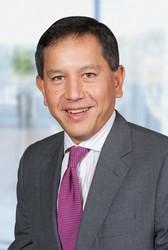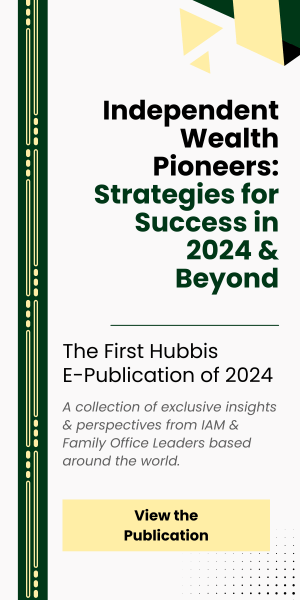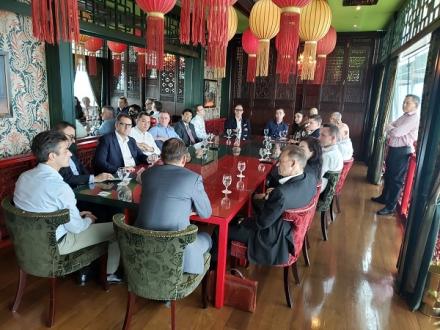Transferring Wealth to the Next Generations – Making the Most of the Opportunity

Mark Nelligan of Pershing Singapore, a BNY Mellon company
Aug 8, 2019
Why should wealth management advisory firms develop strategies to appeal to future generations who are either making or inheriting, Asia’s vast and rapidly expanding private wealth? Many answers were provided in a private, off-the-record discussion that Hubbis co-hosted alongside BNY Mellon’s Pershing Securities Singapore.
Executive Summary
The key is for wealth management advisers to help their Asian high-net-worth (HNW) clients avoid the many pitfalls of unstructured wealth transition planning and the dangers of poor thought and communication. If so, those advisers can reap the benefits from this great opportunity of helping their current and future clients in this challenging, sensitive and absolutely vital endeavour.
Insurance solutions were central to much of the discussion, as the guests debated their value, their acceptance amongst Asia’s HNWIs and families, and the best approaches to enhancing their penetration as a wealth transfer instrument.
The Key Insights
Seeing both sides
Asia is due to follow the trend in the US and also Europe that sees HNW clients and their families looking more broadly at their wealth from both perspectives, assets and liabilities. This offers a great opportunity for wealth managers to incorporate structures and solutions that will address both elements of this equation.
The opportunities are clear, capturing them less so
A guest remarked that the opportunities are obvious, but the challenge is to capture them, especially in unpredictable times for markets and regulatory changes.
The importance of thinking ahead
Tax and regulatory changes are taking place around the globe, including more inheritance tax regimes, as many governments struggle to boost shortfalls in their budgets. In this environment, there are considerable advantages to using structures or insurance solutions in anticipation of these future taxes that could arise. Luckily, for the time being, Singapore is not in this situation, having budget surpluses and no IHT.
Make sure the clients see the issues ahead
There are always changes taking place, for example, in China there is the potential for worldwide taxation ahead. Many clients prefer to ignore the issues ahead rather than addressing them head-on. Wealth managers must challenge this indifference.
The growing role of insurance
Life insurance solutions offer a variety of advantages for wealth and estate planning, including underwriting wealth, de-leveraging and de-risking the family businesses and assets, flexibility, some advantages for the new demands on compliance and reporting, and the provision of cash to settle tax bills in the event of a death.
Plenty of choices
There are more solutions these days than ever before, each one potentially neatly tailored to the needs of the client. In terms of current activity, the most popular currently are the well-established Universal Life (UL), the more recent Variable Universal Life (VUL) evolution and private placement life insurance (PPLI), as well as Whole of Life.
One size does not fit all
From a solutions perspective, the advisers must look holistically at the client’s assets and current and future needs, to promote insurance solutions that in combination make a viable proposition.
VUL – multiple features that appeal
The panel noted that VUL, in particular, has been growing in popularity as it combines the solutions and benefits of universal life and certain other advantages. It can achieve a robust scale of cover at a cost-efficient level achieved partly by allowing the customers use existing assets as premium in kind.
VUL for wealth structures
Another of VUL’s appeals relates to its role in wealth planning and structuring, with its ability to side-step probate another key advantage. In short, according to one insurance expert. VUL therefore actually combines the solutions and benefits of universal life as well as PPLI and is therefore of growing importance in wealth planning and structures.
Seeing the resistance points
An expert in handling family office clients remarked that there is often resistance to structures and solutions, so it often takes an expert hand to guide them through these issues and the structures, for example, complex insurance mechanisms.
Engaging HNW clients
The discussion focused heavily on the difficulty of engaging HNWIs and ultra-HNW clients in a life insurance discussion. Some of the ultra-wealthy have so much money they simply do not see any advantage in another structure or solution. Others have a tendency to consider insurance a solution for their cars, health or their yachts than as an estate planning tool.
Advisers become frustrated
It is well known that the difficulties of promoting life solutions amongst HNWIs are significant enough to make wealth management advisers steer clear of such discussions, preferring to focus on more immediate products to sell.
Simplify the discussion
Different products fit different needs and tackling the different needs of different segments of the family step by step is advisable. The quality of the adviser is therefore increasingly important, helping them promote a simpler discussion. For example, an approach to a founder patriarch might be to address the ability of insurance to look after the needs of the female family members later on.
Promoting insurance as an asset class
Another expert said that it is often useful to begin with a discussion about insurance as an asset class that is both relevant and financially viable for the families and for the EAMs and family offices. Advisers should nurture a more holistic relationship with clients and promote real stewardship, remembering the burden of trust.
Avoid the pitfalls of greed
With commissions so large on some life products and with rebates so significant back to the financial institutions, there is a danger of the wrong type of behaviour being sustained in the banking referral broker model.
Alternatives to the traditional norms
There are today alternatives to the prevailing commission structures, a guest remarked, noting that there are platforms available that rebate some of the hefty commissions built into products for the clients to then reinvest.
Getting past the personal
A guest remarked that there are many personal and structural issues that stand in the way of families discussing life insurance. Helping them see insurance as part of a total wealth and portfolio approach is advantageous. And helping Asian families see the value of wealth preservation is another challenge, especially as Asia has been so dynamic a place for easy wealth creation for so many years.
Governance issues
The importance of understanding and promoting family governance is also a key factor in this endeavour. Families are complex, but with the right governance, the wealth manager’s missions are far simpler.
A new paradigm of preservation
A guest observed that the historical Asian DNA is gradually giving way to a more older money European approach to wealth preservation and the security of family wealth across the generations, all of which will augur well for life insurance solutions.
Reinforcing VUL as a wealth transfer instrument
The discussion closed with a resounding ‘Yes’ from the assembled group of experts, when asked whether VUL will play an increasingly prominent as a wealth transfer instrument.
The Discussion
Mark Nelligan, Chief Executive Officer of Pershing Securities Singapore Pte Ltd, an affiliate of Pershing LLC, a BNY Mellon Company, represented the firm at the discussion and welcomed the 19 experts that Hubbis and Pershing had invited.
“Some of you might have heard of us, some not,” Nelligan began. “Pershing has been servicing external asset managers (EAMs) in the region for several years, but in Asia there has yet to be a what we might call a coming together of the asset and liability management sides of client advisory for HNWIs. In the US, there is a more comprehensive approach to this and part of the mission today for this discussion is to debate what the move towards managing both the liability side and the asset sides for clients actually means for wealth managers.
“There is no need to explain the opportunities, those are obvious for all to see” said one guest on opening the discussion in earnest, “but what is vital is to address the question of how we capture these opportunities, especially in the current environment which is as everyone probably would recognise very unpredictable.”
Be ahead of changes, don’t linger…
He highlighted, for example, the rising prevalence of inheritance tax and estate duty in some jurisdictions, noting that it will be interesting to see if Singapore follows suit. “Governments are strapped for cash, and this whole area presents an opportunity in anticipation of these wealth taxes being introduced,” he remarked, “so for example in Thailand and Pakistan, there are changes taking place, with the common factor being the application of domicile. In anticipation of such changes, do you use a trust or similar structures, not for tax avoidance, but for valid planning and in advance of the changes.”
“It is useful if you are in a jurisdiction which does not yet impose inheritance tax or gift tax to utilise a structure,” he added. “There is a punitive entry tax to structures for those domiciled in the UK, for example. My advice is therefore if you can set up a structure without any type of entry charge, then maybe now is the time to start doing so, in anticipation of these future taxes that could arise.”
Singapore – still in a sweet spot
“My thoughts,” a guest added, “is Singapore will not introduce IHT anytime soon, they will push it back as far as possible because they know there is an advantage to generate real wealth in this city from not being overly regulated. However, eventually they will be forced to do it, but right now I think we are in a sweet spot for a while.”
Another guest agreed, noting that Singapore has budget surpluses and will likely put back any major changes to tax generation that might affect wealth generation and inflows from outside the country. But there are so many countries around the world that are strapped for revenues and drastically altering their tax regimes, Finland being a classic recent example, he said.
“Countries are punitively taxing anyone at any time, retrospectively and even in advance,” he remarked, “for example in some countries tax is due on anticipated revenues, with the authorities usually extrapolating that people will earn more and therefore they are asked to pay even more, and in advance!”
The growing role of insurance
Another guest highlighted the role of insurance. “It locks in current wealth status,” he remarked. “It is not just medical underwriting, but financial underwriting and when you are talking USD50 million and upwards on a single life, locking in that financial underwriting is important from a current wealth status and circumstance.”
Secondly,” he continued, “you are de-risking the portfolio, de-leveraging. Clients will often want to hold cash and non-market correlated, and they will hold fixed interest, so they can assume a different risk status if they offload some of that risk.”
Third, he explained, insurance de-risks the family. “We have clients who were shut down for months due to the Thailand floods some years back,” he recalled, “and some of them would have been wiped out if they did not have cash reserves or insurance reserves. And there is always currency risk, political risk, and regulatory risk. Insurance can therefore guarantee the amount of succession, it can offer guarantees to nominated individuals. And it is flexible, as you can change your beneficiary, particularly when you have complex family structures, second marriages, and so forth.”
Also helpful for compliance and reporting
The final point, he concluded, is that the insurance can be used to pay tax bills. “For example, he noted, you cannot sell assets in the UK to pay tax, so the clients have to find the money somewhere. You can nominate the insurance to meet that tax liability on the existing assets held. And still on the subject of tax, it can simplify tax reporting from a CRS perspective, as an insurance policy can consolidate the assets and have a single line CRS report.”
Structures for a more tailored approach
Another expert picked up on the theme by highlighting the value of different structures, such as Universal Life, Variable Universal Life structure, private placement life insurance (PPLI) and other forms.
“From a solutions perspective it is less about saying there is one product or one solution that suits all,” he commented, “and more about combining forces and then creating a proposition. Being able to take different types of assets into play, holding private company shares as premium for the policy, being able to create some bespoke structuring and charging structures to allow for those family assets to be literally transferred from one generation to the other without falling into estate problems. Ultimately it is about helping families understand the scale of the problem.”
See the problems, address the issues
For example, he said advisers consider some of the recent changes in China and how the authorities are looking at taxing wealth worldwide. “That has had a very significant impact on some of our clients. Not all of them fully understand the size of the problem that faces them, and they are slow to take action. Part of the challenge we have as an industry is highlighting these problems, making sure that clients understand that they have options. And then we must make ourselves part of the solution.”
An expert focused on VUL, which she said helps address the issue of rising interest rates and premium financing becoming too expensive. “It has become more popular in the past 10 years and is another way to obtain very large amounts of life cover and reduce the total cost for the customer by helping the customers use existing assets as premium in kind. With VUL you are actually combining the solutions and benefits of universal life as well as PPLI because you still have the structuring benefits provided within the VUL structure.”
VUL grows in stature
A guest agreed that he had seen the growing acceptance of VUL or some sort of insurance wrapper as increasingly valid for wealth transfer. “Agreed and there are many issues surrounding this,” said an insurance expert, “and yes, premium financing is becoming expensive, so more people are realising the cost efficiency of VUL, as well as the added benefits of structuring wealth at the same time as obtaining a very large amount of life cover. And it does not go through probate, which is another major advantage.”
Adapting the solutions to the market
A banker took the floor, noting that in their business across Asia they are seeing the inter-generational wealth transfer issue rising in importance, with many of the younger Asian generations returning to Asia having been educated overseas. “We are consequently broadening the types of product we offer to these families, expanding from our pure discretionary offering to offer a wider suite of solutions.”
A fellow panellist remarked that in Asia today it is still the founder generation that is making the key decisions, even if the families are much more diverse and many are well versed in Western protocols. “You cannot achieve all the goals in one structure, one solution,” he advised, “so try to capture what is needed for the family as it is now, but then have something which is flexible enough to be adapted to the circumstances in the future, whether it is the regulatory environment, or changing family circumstances. And the solutions, whether trusts, or insurance, must interact properly.”
Seeing the resistance points
An expert in handling family office clients remarked that there is often resistance to structures and solutions. “Some solutions scare clients away somewhat,” he said, “so it often takes an expert hand to guide them through these issues and the structures, for example complex insurance mechanisms. This can also often be impeded by the clients’ tax or accounting advisers resisting ideas, so it takes a seasoned expert to overcome many of these hurdles.”
“Yes,” said another guest, “for example the private banks work with the insurers to sell products, but to get these deals over the line they, and other wealth advisers, really need to bring in an expert insurance broker who really specialises in high net worth insurance.”
The UK – a case in point
A guest highlighted UK residential property held through companies, noting that if a client settles the company shares into a trust it represents a chargeable transfer that would now attract a 20% charge, even for a non-domiciled client. “That route is now blocked,” he said, “but potentially an interesting solution is for the shares to be used as premium, and then effectively the life policy that you then hold instead of the shares can still go into a trust. That type of quite sophisticated tax planning allied to insurance is quite interesting for the UK market.”
Picking up on the UK theme, another expert remarked that Asia investors have a tremendous amount of property in London and the UK. “So many have been sold these structures where they setup BVI, hold the property in BVI structure and think that will avoid IHT there,” he commented. “And there are still property portfolio managers flogging that. But a lot of these structures that have been running for 10 years plus and need to be looked at by our industry and revised or refreshed. But an issue is getting to the clients to have that conversation, it can be somewhat painful.”
Engaging HNW clients
The discussion evolved naturally towards engaging ultra-HNW clients in a life insurance discussion. “I remember one such person saying to me that he had so much money he could just keep so much in cash and not bother with other structures or risk,” recalled one attendee.
“To be honest,” reported another guest, “often the longer the advisers, the specialists have been in the business, perhaps the less they want to talk about insurance. It is really all about the quality of the advisers we put in front of the client, and here I am not talking about insurance agents, I mean wealth management professionals. And then address issues one by one that engage the clients, for example looking after the women in the family through insurance planning, that is usually a simpler discussion. Or addressing the issue of the securing of debt, so let’s have a term life discussion. Different products fit different needs and tackling the different needs of different segments of the family step by step is advisable.”
Promoting insurance as an asset class
Another expert said that it is often useful to begin with a discussion about insurance as an asset class, rather than looking at it just as another cost for insurance, for example for a yacht or a house or whatever. He said that in the family office context insurance can be seen as a bit of a dirty word. “In the family office space,” he commented, “it really is down to price and the delivery of a proposition to that client that is not only justifiable in terms of cost but that delivers value for what you are offering. It is a key challenge in this space to build something that works outside of the existing banking referral channels, that is relevant and financially viable for the family offices.”
Another attendee agreed, remarking that to provide the alternative to the EAMs and family offices as a custodian outside the private banking network is a great opportunity. “If we present insurance more as an asset class for investment, and not insurance for insurance, that is where we get excited because then we offer the custody type solutions that sit behind.”
Be careful, sell what is valuable
“One must be careful to avoid churn,” another participant observed, “and to produce insurance solution good for the people who buy it, not only for those who sell it. When you have a more holistic relationship with clients and also real stewardship, the burden of trust, you have to avoid the sub-optimal product.”
“There is certainly a belief that insurance is a retail, mass affluent solution,” observed another guest, “and unfortunately the current broker-banking model, supports that to some extent. We have conversations with some of the brokers that we work with and I question their professionalism to some extent because not every broker has the technical qualifications that would support a financial planning operation. I sit around the table sometimes with the chief financial officer of the first gen, and second gen family offices, I am the insurance representative and we will have the broker in the room, and I would say the broker in some cases is the weakest link. You really need to find through either networks or your own referral connections someone credible to put in that room with your client.”
Be on your best behaviour
He added that with commissions so large on some products and with rebates so significant back to the financial institutions there is a danger of the wrong type of behaviour being sustained in the banking referral broker model. “You need to build a proposition that you can credibly take to your clients, to offer insurance, investments, discretionary capabilities, and try to disintermediate the current distribution model to some extent,” he elucidated.
“It was easier to raise these discussions when Singapore had estate duties,” said one attendee. “It was then easier to broach the subject of life insurance as a tax planning and mitigation tool. With the advent of tighter regulations worldwide, I think some of these conversations will be easier and more meaningful but in general we will ensure we keep the client’s best interest at the centre, for the business side and for asset protection.”
Seeing beyond the traditional norms
And as to the commission structures, a guest remarked that it is no longer obligatory to work within the confines of that traditional compensation model that the banks and the insurance brokers use. “I am working with a platform now,” she explained, “and they are about to launch a version that will essentially rebate the compensation that has been priced in back to the customer and allow that customer to just invest more into their platform.”
Getting past the personal
A guest remarked that there are many personal issues that stand in the way of families discussing life insurance. “But from a portfolio perspective I agree that if you look at it from an asset class people listen up,” he said. “They realise, I am de-risking my portfolio by doing this. And the other element is to advise them not to fund premium by just pulling it out of the bank in cash, they can fund the premium through an asset class, fund it through buying into a fund that will give them an income stream to fund that premium.”
“We all need to think further up the curve, more like the European scene where the families and family offices represent the sixth, seventh or eighth generations and have a more sophisticated and balanced way of looking at their portfolios and situation,” he continued. “And to bring this discussion to the different generations of the family as early as possible and build communication within the family is vital.”
Governance will play a role
A guest picked up on this, noting that the theme of family governance is a key area to explore. “I think all these discussions around the table are possible when there is family governance and understanding between the patriarch and the next generations as to what they would like to do,” she remarked. “But if there is a discord between the next generation and the patriarchs or the matriarchs, you have a tough task and the relationship manager for example has to decide how much traction they will achieve in reality to change the mindset of a family. Sometimes it is extremely hard work if some family members turn against you because they might want to do things that are not necessarily beneficial for the entire family. It is an issue that I am constantly wrestling with.”
“Is it just that some people do not necessarily move with the times and hence are stuck in their old realities” came a question form the group.
Be realistic, assess the viability
“It often depends on whether the younger generations are more interested in luxury lifestyles or actually adding value to the family, to put this in a very simple way,” was the reply. “But I think getting into conversations about complex insurance solutions, trusts and so forth, can only be fruitful and productive if the family is largely on the same page. The RM needs to establish that quite early on, as they also need income, they need to earn, so do not want to waste their time.”
“Yes,” said another guest, “and realistically the banker only has a relationship with certain members of the family, they don’t have a full picture.”
Are the building blocks in place?
Returning to the topic of family governance, a guest observed that if the first and second generation has done a good job, there is typically a family governance and there is a greater sophistication and interest in preserving wealth. “But if that first generation has done a very bad job in teaching their children about family governance and what the goals of the family should be, then the RM is in a very tight spot. Are they going to spend their time trying to educate the next generation on these matters? It is a key challenge we often face.”
A new paradigm
As the discussion neared its end, a guest observed that in Asia there remains in the DNA the old way of thinking that everything is up and down, but that wealth is there to be made constantly as the situation is so encouraging and has been for so many years. “The old mentality in Asia is different from the situation in Europe, where wealth is preserved through more generations,” he said, “so in Europe we see the sixth and later generations see our job as making sure that we look after that wealth and they don’t lose any money. Don’t need to make any, but just don’t lose any. It is a different mentality.”
VUL’s rising star
The discussion closed with a resounding confirmation from the assembled experts, when asked whether variable universal life (VUL) will play an increasingly prominent as a wealth transfer instrument.
VUL is ideal, as the experts had reported during the discussion, as a tool to address the issues of rising interest rates and premium financing for products such as Universal Life becoming too expensive. Moreover, VUL side-steps the probate process.
Accordingly, VUL can help achieve the client large scale life cover, as well as a reduced cost through the use of existing assets as premium in kind and thereby boost the proposition for its use in wealth transfer planning.

Chief Executive Officer at Pershing Singapore, a BNY Mellon company

More from Mark Nelligan, Pershing Singapore, a BNY Mellon company
Wealth Solutions & Wealth Planning
Pershing’s Mark Nelligan on How Advisers Stay Relevant in the New Age of Advice
Latest Articles






